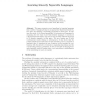Free Online Productivity Tools
i2Speak
i2Symbol
i2OCR
iTex2Img
iWeb2Print
iWeb2Shot
i2Type
iPdf2Split
iPdf2Merge
i2Bopomofo
i2Arabic
i2Style
i2Image
i2PDF
iLatex2Rtf
Sci2ools
ALT
2006
Springer
2006
Springer
Learning Linearly Separable Languages
This paper presents a novel paradigm for learning languages that consists of mapping strings to an appropriate high-dimensional feature space and learning a separating hyperplane in that space. It initiates the study of the linear separability of automata and languages by examining the rich class of piecewise-testable languages. It introduces a high-dimensional feature map and proves piecewise-testable languages to be linearly separable in that space. The proof makes use of word combinatorial results relating to subsequences. It also shows that the positive definite kernel associated to this embedding can be computed in quadratic time. It examines the use of support vector machines in combination with this kernel to determine a separating hyperplane and the corresponding learning guarantees. It also proves that all languages linearly separable under a regular finite cover embedding, a generalization of the embedding we used, are regular. 1 Motivation The problem of learning regular l...
ALT 2006 | Corresponding Learning Guarantees | Machine Learning | Separating Hyperplane | Smallest Automaton |
| Added | 14 Mar 2010 |
| Updated | 14 Mar 2010 |
| Type | Conference |
| Year | 2006 |
| Where | ALT |
| Authors | Leonid Kontorovich, Corinna Cortes, Mehryar Mohri |
Comments (0)

